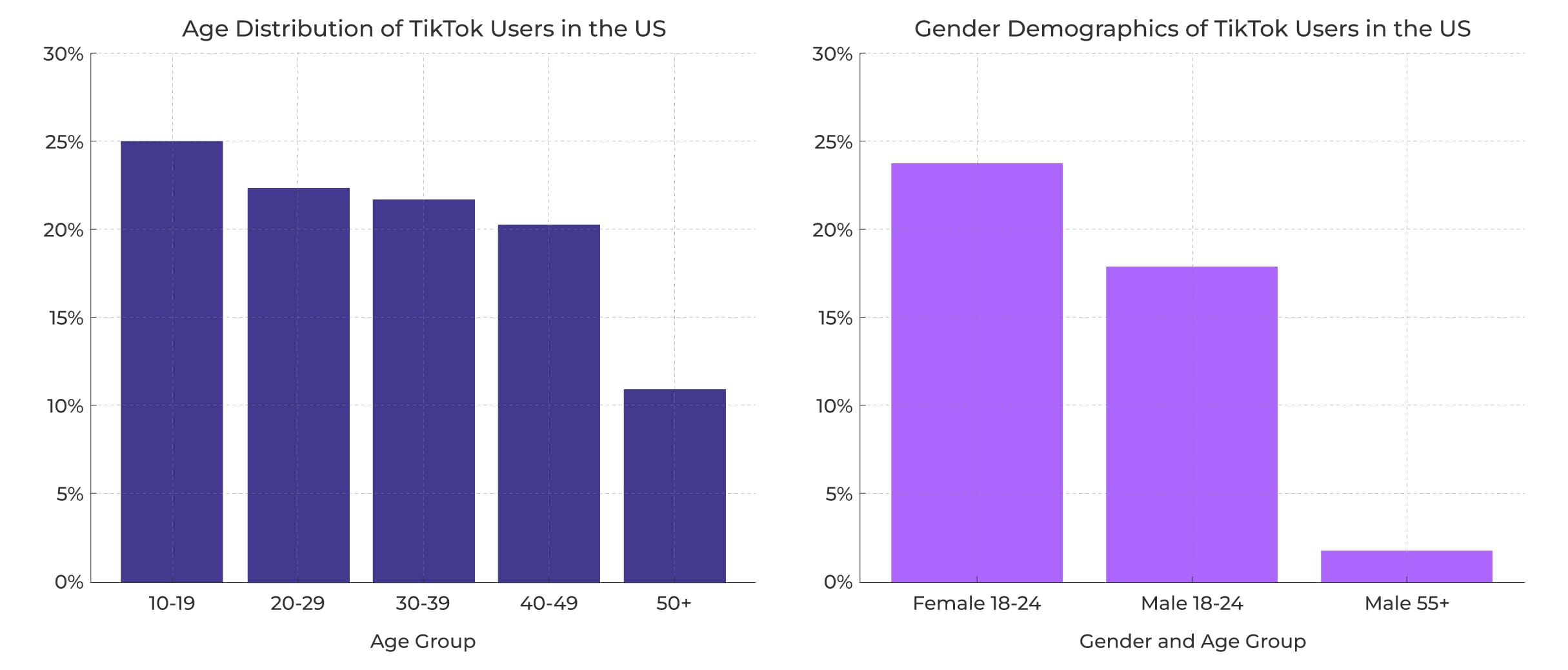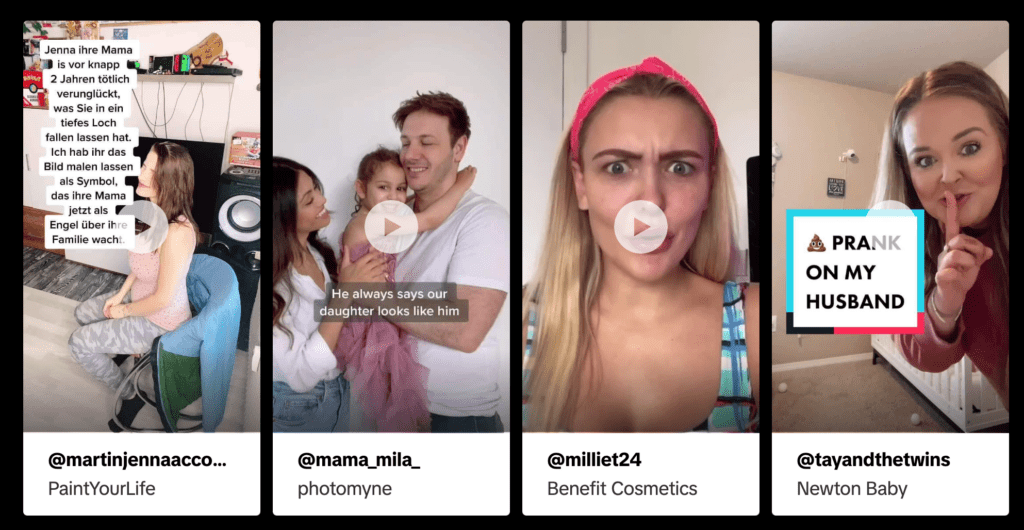Attention is the new currency, TikTok has emerged as the latest platform for marketers’ hearts and of course their budgets. With its endless scroll, catchy music, and viral dances, TikTok paints a picture of an advertiser’s dream: a world with endless possibilities to capture and engage.
Table of Contents
Beneath its trend-setting surface lies a complex, often misunderstood advertising platform that demands a second look.
To give you a feel of our journey and successes with TikTok, let’s start with some stories close to our hearts. Our case studies, like the ones with BIGVU and Petit BamBou not only showcase our proficiency but also a deep understanding and effective use of TikTok’s unique platform capabilities.
Before you dive headfirst into TikTok’s advertising platform, pause and consider: Is it the marketing it’s hyped up to be, or a mirage that could lead your brand astray?
Limitations of TikTok’s User Demographics for Certain Apps and Products
We all know TikTok’s user base consists of younger audiences. Research shows that 60% of TikTok’s global users are aged between 18 and 24, which has its pros and cons.
Brands like Chipotle have successfully tapped into this young audience, leveraging viral challenges to drive remarkable engagement. But what if you have a product or service that caters to an older or more affluent audience? Can you still hit the same level of virality?
Well, it depends…
While TikTok is a fantastic playground for brands eager to engage with a young, vibrant crowd, it might not hit the mark for products or services that are aiming to charm an older, more affluent audience.
- In terms of age distribution in the United States, the largest proportion of TikTok users (25%) are aged 10 to 19 years. This is followed by 22.4% in the 20-29 age group, 21.7% in the 30-39 age group, 20.3% in the 40-49 age group, and 11% aged 50 and above.
- Gender demographics indicate that the majority of TikTok users are female (57%), with female users aged 18-24 years representing the single largest group at 23.8%. Male users in the same age bracket constitute 17.9% of the user base. Notably, the platform is less popular among male users aged 55 and above, who make up only 1.7% of the audience.

TikTok User Age, Gender, & Demographics (2023)
For instance, a luxury watch brand would need significant help finding its target demographic of affluent, older consumers on TikTok. This raises the critical question: are your advertising dollars justifiably spent on this type of advertising?
Brands need to carefully assess the demographic alignment of their target audience with TikTok’s user base to determine the platform’s suitability for their marketing goals.
It’s really important to dig into the spending habits of TikTok users and get a feel for the kind of content they love. This helps us get a clearer picture of how to shape your marketing strategies on the platform.
Spending Power and Content Preferences:
TikTok is often underestimated in spending power and presents a unique challenge for advertisers, particularly for upscale or luxury brands. This younger demographic, typically having less disposable income, can be a tough crowd for brands that don’t naturally click with their trend-focused style.
The content on TikTok, revolving around trends, music, and entertainment, is a big hit with younger audiences. However, this presents a bit of a gap for products or services that are more serious, professional, or in niche markets like B2B services or specialized software. These typically appeal to a more mature, professional crowd, like cloud software for big enterprises or legal firms, which may struggle to find their footing on a platform where the user base skews younger and the decision-making process is less complex.
This gap between TikTok’s audience and the needs of certain brands highlights the need to understand how your brand is perceived and how loyal your customers are. Understanding TikTok’s unique scene, which is quite different from other social platforms like Instagram or Facebook, requires a strategic touch.
Connect with the TikTok audience – nativeness is key!
To connect with TikTok users, it’s crucial to craft original content specifically designed for the platform, not just rehashed from other campaigns. Using TikTok’s native ad formats, like Spark Ads, lets brands create in-feed ads that feel more organic and tend to drive higher engagement.
Choosing the right type of TikTok ad, from TopView and Brand Takeovers to In-Feed Video Ads and Branded Effects, is massive for grabbing attention.
Adapting to TikTok’s unique platform calls for a mix of creativity, strategic thinking, and a deep dive into the platform’s audience and trending content. For high-end brands and B2B services, it’s all about finding clever ways to engage with this younger audience while staying true to your brand’s identity.
Brand Perception and Customer Loyalty Concerns:
Jumping onto a platform known for its humorous content can truly stir the pot for a brand’s image. For those established Fortune 500 brands out there, it’s a tough balancing act to keep up with. They run the risk of softening their well-established brand persona or inadvertently drifting away from their core customer base by plunging into TikTok’s trend-focused universe.
Take Buzzfeed for example. They have seen success on YouTube and Instagram, but when it came to TikTok, things didn’t quite click. Buzzfeed tried to reuse their content from other platforms on TikTok without tweaking it to fit into TikTok’s trendy vibe.

The result? Their content didn’t resonate with TikTok users. It lacked that fresh, trendy feel that TikTokers love. This approach didn’t do much to draw in the TikTok crowd or tap into the platform’s vast network of influencers. In the end, they saw their engagement rates and follower growth stagnate, missing the massive reach of connecting with the TikTok community.
The TikTok platform’s trend-driven content poses challenges in building customer loyalty as well.
Apps and products aiming for long-term customer engagement struggle to find this on TikTok, where the audience’s interests are constantly shifting with the latest trends. This is great if you have a hyper-causal app you would like to promote, but probably not the best if you are looking to build lifetime loyal customers.
Regulatory Complexities:
In 2023, TikTok stepped up its game in the world of data privacy and security.
They kicked things off by setting up the TikTok US Data Security (USDS), a big move that was about taking better care of user data in the U.S. This was a pretty big deal because it showed they were serious about handling data responsibly, especially with all the eyes of the world on them.
TikTok also had plans to open up a data center in Dublin. This was their plan to keep UK and European user data close to home, cutting down on sending data across borders and saving on infrastructure costs. It was a good-faith move to show respect for Europe’s tight data privacy rules.
Security-wise, they didn’t hold back either.
TikTok dove deep into their security practices, bringing in top-notch security experts and growing their teams. TikTok even opened up Transparency Centers in L.A. and D.C., where experts and lawmakers could come in and get a behind-the-scenes look at how TikTok keeps its platform secure.
Even with all these efforts, TikTok is still under pressure from the public. The fact that they’re a Chinese company, and have spied on reporters in the past, and the whole mystery around how they use data means people are still a bit wary.
For advertisers thinking about diving into TikTok, this is something to consider. If the US will be completely banning TikTok, you could be heavily affected, if you’re marketing there.
Content Saturation on TikTok
TikTok’s content saturation can be quite a hurdle when you’re aiming for high visibility and viral success with your ads. The sheer volume of content, mixed with the platform’s algorithmic tendencies, makes it quite challenging. This is particularly true for newer or less established advertisers seeking to make the most out of their dollars.
The Volume of Content:
TikTok is booming with content, as millions of videos get uploaded every single day. This makes it challenging to make your content pop and grab attention. Even top-notch, highly engaging ads can easily be overshadowed in this constant stream.
When you factor in the notoriously brief attention spans of the TikTok audience, the task of crafting an ad that not only captures attention but also resonates deeply becomes even more challenging.
You’re tasked with not just breaking through the noise but also making a meaningful impact in an extremely short window of time.
Clout-Chasing on TikTok?
A lot of advertisers on TikTok get caught up in the rush to hop on the latest trends, hoping to ride the wave of whatever’s hot at the moment. But this strategy can backfire, leading to content that feels forced or unauthentic, potentially alienating your audience or even harming your brand’s reputation.
Chasing virality on TikTok might bring a quick boost in visibility and engagement, but it’s not a recipe for long-term success.

Trends on the platform are notoriously short-lived. This brief moment of fame doesn’t turn into long-term growth for your brand or build deeper connections with your customers.
Privacy and Data Limitations
If you’re thinking about using platforms like TikTok, it’s important to stay tuned to the big changes in user privacy and data protection. Everything’s evolving quickly, and these shifts are changing the game in how we use personal data for targeted ads.
There’s been a global movement towards strengthening user privacy, a trend driven by increased public awareness and regulatory actions. Regulations such as the GDPR in Europe have set stringent rules on personal data handling. This means platforms like TikTok are now more restricted in how they use detailed user information, including demographics, behaviors, and interests.
What’s critical here is the requirement for user consent. TikTok and similar platforms must obtain clear permission from users before collecting data, and users have the right to revoke this consent at any time.
As a result, TikTok is moving towards anonymizing and aggregating user data. This is ideal for keeping user privacy intact, but it does mean that the detailed data you might need is not as readily available. This shift poses a challenge for personalized ad campaigns, potentially leading to less relevant ads and a lower ROI on your campaigns.
Also, the global presence of TikTok means dealing with loads of privacy laws in different regions, which adds layers of complexity to your targeting strategies, especially if you’re looking to reach a multinational audience.
In this evolving scenario, we need to adapt.
This might involve exploring new technologies for privacy-compliant data collection and finding innovative ways to engage users who don’t rely heavily on personal data. Plus, there’s a rising trend of contextual advertising, where the focus is more on where the ad appears and the surrounding content, rather than on the user’s personal data. It’s a strategy that can be less invasive and more aligned with current privacy standards.
While TikTok remains a powerful platform for reaching a wide audience, these privacy and data limitations mean we need to rethink our approach. It’s about striking a balance between effective targeting and respecting user privacy.
Our Final Thoughts
TikTok stands as a new and vibrant platform for advertising, offering a world of possibilities for those looking to capture the attention of a younger audience.
However, brands must navigate this space with caution. Aligning with TikTok’s core demographic means not only understanding their interests but also ensuring that your products or services resonate with this audience.
If you aim to expand your reach to younger consumers, remember that success on this platform requires more than just visibility: your ads and products must genuinely connect with their lifestyles and values. A misstep here could lead to not just wasted ad spend but potentially harm your brand’s reputation. TikTok is a playground for experimentation and engagement, but like any powerful tool, it requires a strategic and thoughtful approach to harness its full potential without straying from your brand’s core identity.



